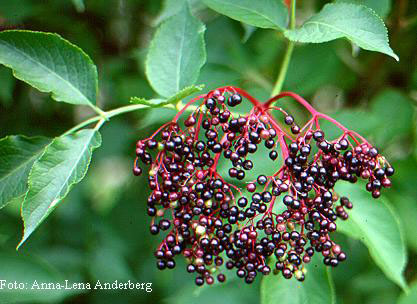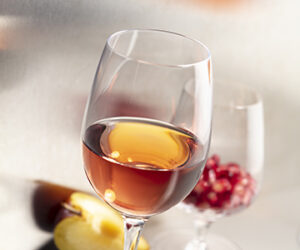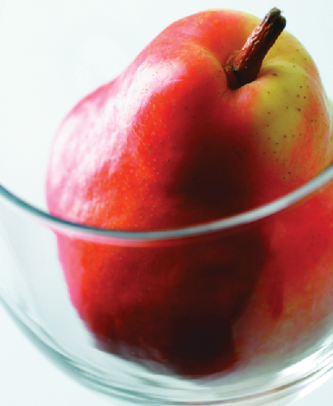 Its shrub is known as “the medicine chest of the common people.” The root, bark, berry, leaves, and flowers have been used by herbalists for thousands of years. The flowers have been used topically in ointments and poultices for cuts and scrapes. The berries are a good source of Vitamin A and C and are most often used in making pies, wine and jelly. This berry was immortalized in song by Elton John. It’s elderberry, and you also can make fine wine with it.
Its shrub is known as “the medicine chest of the common people.” The root, bark, berry, leaves, and flowers have been used by herbalists for thousands of years. The flowers have been used topically in ointments and poultices for cuts and scrapes. The berries are a good source of Vitamin A and C and are most often used in making pies, wine and jelly. This berry was immortalized in song by Elton John. It’s elderberry, and you also can make fine wine with it.
Warmed elderberry wine has been made for centuries as a remedy for sore throats and the flu. In the last twenty years, clinical studies have confirmed the elderberry connection in reducing the duration of influenza-like symptoms.
Berries gathered from the European black elder known as Sambucus nigra (pronounced sam-BOO-cuss NIGH-gra) and the American sweet elder Sambucus canadensis (can-a-DENSE-sis) make tasty wine. The berries from most varieties of Sambucus nigra and Sambucus canadensis make red wine.
White wine can be made from the yellow fruit of the frutuluteo or the green fruit of virescens. Other varieties of the Sambucus family exist, but are not the focus of this article. Elderberry wines made from the black and blue-black berries range in color from a light ruby to an inky-purplish color. Wine made from green or yellow berries is usually pale yellow with a light-greenish tint.
When you sniff elderberry wine, you get an unmistakable aroma of berries. This is not a shy, elusive berry wine! Although different varieties can vary in berry intensity, it is never a wimpy wine. Additional descriptors can include floral, perfume, spiciness and earthiness. These wines usually have crisp acidity.
There is no middle ground with this wine. If blush wines are your specialty, elderberry rosé can be made by limiting the quantity of berries and the length of time the berries are fermented in the must. If you prefer big, robust wines, increase the fermentation time and keep the berries submerged in the must. If dry wine is not to your liking, you can make elderberry wine with varying residual sugar levels, including a sweetened, fortified port style. Sounds like something for everyone!
Important note: Do not eat or use the roots, leaves, and stems. They are poisonous! The unripe, uncooked berries have a purgative effect (which means they can cause nausea, vomiting, and diarrhea).
A Bit of Botany
Elderberries are native to Europe, Asia, and North America. They grow in temperate and semitropical regions, which include nearly all of the United States, southern Canada and parts of Mexico. They are considered hardy shrubs in USDA Growing Zones three through eight, where the average annual minimum temperature range is between -40 to 20 °F (-40 to -7 °C). For more information, go to www.usna.usda.gov/Hardzone/ushzmap.html.
Optimal conditions include sandy or loamy soil (rich in humus and nitrogen), and full or partial sun. Elderberry plants are known as the “gardener’s friend” because they will grow in a variety of soils and sites and do not require much attention.
They are pest-free and need no spraying. They are easily propagated with cuttings taken in July or August and can bear fruit within eighteen months of planting. Some bushes grow in colonies by producing “stolons” (runners) that spread along the ground, take root, and form new plants. Elderberry colonies commonly grow along highways, country roads and meadows.
It is a deciduous shrub that can be grown as a tree. The average height is 8–12 feet (2.4–3.6 meters), but some species can reach 50 feet (15.2 meters). If the shrub is properly pruned for a year or two, and branches begin at approximately 40 inches (1 meter) from the ground, the plant will cease putting out runners and will become tree-like.
Sounds pretty easy, right? If you are interested in planting your own elderberry bushes, the largest supplier of these plants is Margaret Tidwell, Route 1, Box 137, Eufaula, OK 74432. Phone: (918) 452-3789. She has many varieties and includes growing instructions with the plants. Tidwell does not have a Website. However, her daughter can be emailed at: [email protected].
Some varieties make better wine and elderflower infusions than others. So, if you are picking elderberries from several locations, keep good tasting notes on each batch of wine as well as a record of where you picked the fruit.
It is also important to note that some varieties are not edible. The dwarf or ground elder, Sambucus ebulus, is unsafe for winemaking or consumption. It bears pinkish-white flowers in groups of three. The fruit is black and looks like Sambucus nigra. Fortunately, this variety does not regularly bear fruit. If the berries do not grow in a spray cluster formation, “Don’t pick them and don’t eat them! They are probably poisonous!” says Dr. John A. Brewer, winemaker and elderberry expert at the family owned and operated Wyldewood Cellars Winery in Mulvane, Kansas (near Wichita).
Elderberries belong to the honeysuckle family, Caprifoliaceae. The next time you see the elder bush or tree in bloom, notice the flower shape is similar to the honeysuckle blossom. However, some varieties are more fragrant than others. Needless to say, pick the flowers and fruit most favorable to your liking. The plant itself, however, does not exude an appealing odor. This may be one of the reasons it is pest-free. The stems are thick, soft and easy to hollow, which is why they were used for musical pipes thousands of years ago.
Harvesting the Berries
Harvest for the flower can run anytime within the months of May, June, and July, depending on climate. Elderflowers are pleasantly scented and ready for harvest when all the flowers in a cluster are open. Fresh elderflowers dipped in batter and fried make a wonderful dessert fritter (cut off the small stems before serving). Most flowers are white- or cream-colored, with a flat top and disc-like clusters, although certain varieties have pink flowers. They bloom from the outer portion of the cluster inwards. Pick when the inner blooms are all open but before the outer blooms are full-blown. If you wish, dry the elderflowers so that they can be added when making elderberry wine.
As a home winemaker you may use up to 8 grams (3/4 pint or 353 mL) of loosely packed dried elderflowers and 15–18 pounds (7–8 kg) of elderberries to make 5 gallons (19 L) of wine. One or two level, loosely packed tablespoons of dried elderflowers can also be added to five gallons of red or white grape must when a perfumed aroma is desired.
Elderberries are ready for harvest when all of the berries in the spray cluster turn a black-violet color and are soft and easily squashed by your fingers. There are elderberries of other colors including red, blue, white, yellow or green, and these berries, obviously, will not turn black-violet in color when ripe. Only the black and blue-black berries have medicinal value.
The cluster, including the stems, is known as a spray cluster or umbrella. Ripe berries weigh heavily on the stems, causing the fruit to droop and make the cluster look like a partially opened umbrella.
When picking the fruit, do not layer too many berries because the weight will crush the berries. Cut the cluster of fruit with pruning shears or scissors. Place the clusters in a porous container, such as a fruit box or clean cardboard box with holes on the sides. You can separate the fruit from the stems with a dinner fork. It is recommended to begin the winemaking process immediately to prevent the growth of mold on the fresh berries. Or, freeze the berries for use at a later time. Note: Don’t place the berries next to the frozen onions or peppers unless you are keen on that aroma in your wine. These odors can transfer!
Fermenting Your Wine
Each berry contains two or three small, flattened seeds, also known as stones. Winemakers should not crack or pulverize the seeds because they, like grapes, contain oils and tannin. The elderberry juice contains plenty of tannin, and additional tannin is released from the skins when pressure is exerted on the fruit at pressing time. To avoid an excessively tannic and bitter wine, apply gentle pressure or allow the fruit to drip from the straining bag. The result will be a wine that can be bottled in six months.
The length of time the fruit is in the must (juice) and the temperature at the time of fermentation is also worth mentioning. Many elderberry recipes suggest aging the wine for a year or more before consuming. These wines are most often “claret” style wines, and are generally drier and more tannic. The fruit is left in contact with the must for seven to 14 days (sometimes it is submerged longer) and are fermented at temperatures of 72 °F (24 °C) or higher. A fruity style elderberry wine can be made when the fruit is removed from the must after 3–5 days and the fermenting temperature is approximately 65 °F (18 °C).
If you are ready to make elderberry wine and do not have a source of fresh elderberries, no worries! Canned and dried elderberries and dried elderflowers can be obtained at your local wine and beer hobby supply store.
Adding bananas to the must will help to produce more body (mouthfeel) and, hopefully, extend the length of time you taste the fruit. Although this wine will not be excessively astringent, some winemakers may choose to sweeten it with sugar.
Sweetening any berry wine will boost the berry flavor (just make sure you stabilize the wine with metabisulfite and inhibit the yeast from refermenting by adding potassium sorbate). The level of sweetness is usually dictated by personal preference.







